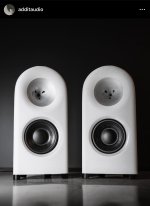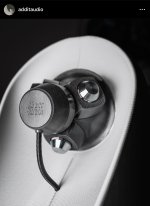If I did want an extra reflex port... I'm not sure what I'd do with it; it might require the cone to be longer/bigger, or to be pointed out the back, which aren't really very appealing options. TBH I'm just hoping not to go there.
I'm not sure the ports really need to be in an exact position.
On the MF driver baffle side, 4 of.
You'd have to have a rear cab enclosure tuned to suit.
I found that out - volume matters.
Enclosure adds weight and size though.
My SH50 rear enclosures are almost as heavy as the horns and flares!
Esp suitably damped with bitumen sheeting.
Could be removeable for transportability though.
All said you might be just fine with taps and subs that run higher - horses for courses.
Really cool project.
Wow, you are doing exactly what I've not had the courage to do yet, a SM-60 coax style.experiment with pro coax in the style of Danley patent fig 7 and renkuz-Heinz coentrant driver and it’s a really nice way to get the midrange taps close to the tweeter and potentially make it as compact as possible.
This is also really cool!
I will follow with excited anticipation.
Go for it, the 6” is cheap, they even provide a cad model on their site https://www.redcatt.net/cx6f-140f.html
https://redcatt.de/REDCATT-CX601X8
https://redcatt.de/REDCATT-CX601X8
Wow, that is a good price.Go for it, the 6” is cheap, they even provide a cad model on their site https://www.redcatt.net/cx6f-140f.html
https://redcatt.de/REDCATT-CX601X8
Thank you for your posts and ideas. I'd run across suggestions and examples of different types of coentrant and coaxial drivers (as well as the more common coaxial ring compression drivers), but your work is particularly impressive; very neat indeed.Not going in to details here...
It is wonderful what can be done with 3d printing, combined with clever design, these days. I'm still clinging to the idea of making my horn/waveguide without printing (I'm intending to only make two, and then stop). But I do wonder how long it will be before I weaken and save up for a printer.
I also think the cardioid approach is quite interesting for directivity control, and I like your design. I would probably need something bigger than your example but it would indeed still be much smaller than a <500hz horn. In my case though I can simply use sufficiently large horns, so on balance I happen to prefer this route; they just need a little inventiveness, to allow them to pack down smaller for occasional storage and transport etc.
A printer is such a nice addition in the arsenal of tools. I only wish I had a bigger printer..
More inspiration for leaking midrange.
https://www.instagram.com/s/aGlnaGx...3099086584270671090&igsh=MW42MzlnaDkzOW56bA==
More inspiration for leaking midrange.
https://www.instagram.com/s/aGlnaGx...3099086584270671090&igsh=MW42MzlnaDkzOW56bA==
Attachments
That does seem to be a common theme. Almost everyone who has a 3d printer (wrt horns) would like a bigger one. Maybe one day I'll get or make one.
On a different note, another common theme with MEHs is that many DIYers who make one seem to later try different/improved versions. Sometimes multiple times. So, in spite of my initial ideas, which are getting quite narrow, I'm starting to think that my best route would be to buy drivers that are known to work in many/most MEH designs. I'm not rich enough to simply cast them out if/when I try a different mkII.
On a different note, another common theme with MEHs is that many DIYers who make one seem to later try different/improved versions. Sometimes multiple times. So, in spite of my initial ideas, which are getting quite narrow, I'm starting to think that my best route would be to buy drivers that are known to work in many/most MEH designs. I'm not rich enough to simply cast them out if/when I try a different mkII.
So, in spite of my initial ideas, which are getting quite narrow, I'm starting to think that my best route would be to buy drivers that are known to work in many/most MEH designs. I'm not rich enough to simply cast them out if/when I try a different mkII.
In the above picture, I can make out the B&C label, and they appear to be the 4DNF34 from the rear magnetic structure. I use these, Mark100 and Weltersys use these as well.
In my multiple entry horn use case, a modified 18 Sound XT1464, they cross to a 3" diaphragm compression driver at just under 1khz. If the 4NDF34 is a bit expensive for your budget, the Celestion closed back 4" and 5" midrange drivers have been used before as well.
Yes, the 4NDF drivers seem a pretty safe bet. Taller than e.g. the faital 3" but in the scheme of things, perhaps not massively so.
I might also consider stepping up to 10" for the bass drivers, there seems more choice with suitable perameters, and more common usage (in MEHs) than 8". 8" is only midrange territory for some people - e.g. if using with a big direct radiator for bass. 10" is only a small increase, whereas 12" starts to become more significant; width-wise as well as in depth.
I might also consider stepping up to 10" for the bass drivers, there seems more choice with suitable perameters, and more common usage (in MEHs) than 8". 8" is only midrange territory for some people - e.g. if using with a big direct radiator for bass. 10" is only a small increase, whereas 12" starts to become more significant; width-wise as well as in depth.
Yeah I have to confess that it’s not my first time dabbling with MEH’s. My first was a classic approach with BMS 4550, 3fe25 and four sica 6”.On a different note, another common theme with MEHs is that many DIYers who make one seem to later try different/improved versions. Sometimes multiple times. So, in spite of my initial ideas, which are getting quite narrow, I'm starting to think that my best route would be to buy drivers that are known to work in many/most MEH designs. I'm not rich enough to simply cast them out if/when I try a different mkII.
But they are not allowed in the house..
And the journey, experiments and fiddling is my goal rather than a finished product.
- Home
- Loudspeakers
- Multi-Way
- Multiple Entry Horn with removable mouth?

